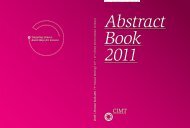Abstract Book 2010 - CIMT Annual Meeting
Abstract Book 2010 - CIMT Annual Meeting
Abstract Book 2010 - CIMT Annual Meeting
Create successful ePaper yourself
Turn your PDF publications into a flip-book with our unique Google optimized e-Paper software.
062 Ashfield | New targets & new leads<br />
ImmTACs: bi-functional reagents for redirected tumour<br />
cell killing<br />
Rebecca Ashfield 1 , Linda Hibbert 1 , Nathaniel Liddy 1 , Giovanna Bossi 1 , Katherine Adams 1 ,<br />
Anna Lissina 2 , Tara Mahon 1 , Namir Hassan 1 , Jessie Gavarret 1 Frayne Bianchi 1 , Nicholas<br />
Pumphrey 1 , Kristin Ladell 2 , Emma Gostick 2 , Andrew Sewell 2 , Nikolai Lissin 1 , Peter Molloy 1 ,<br />
Yi Li 1 , Brian Cameron 1 , Malkit Sami 1 Emma Baston 1 , Penio Todorov 1 , Samantha Paston 1 ,<br />
Rebecca Dennis 1 , Andy Johnson 1 , David Price 2 , Annelise Vuidepot 1 , Daniel Williams 1 , Bent<br />
Jakobsen 1<br />
1 Immunocore Ltd, 57C Milton Park, Abingdon, Oxfordshire, OX14 4RX UK<br />
2 Cardiff University School of Medicine, Heath Park, Cardiff, CF14 4XN, Wales, UK<br />
The human immune system can theoretically<br />
identify malignant cells by inspecting cell surface<br />
Class I HLA -peptide complexes for the presence of<br />
disease-associated epitopes. Indeed, many cancer<br />
patients generate CD8 cyto-toxic T cell responses<br />
to tumour-associated antigens; the majority of patients,<br />
however, fail to clear tumours since T cell<br />
avidity for self-antigens tends to be weak, and<br />
cancer cells employ escape mechanisms for avoiding<br />
destruction by T cells. To overcome these<br />
issues, we have engineered novel, bi-functional<br />
protein therapeutics termed ImmTACs (Immune<br />
Mobilising mTCR Against Cancer) which re-direct<br />
the immune system to target and destroy tumour<br />
cells with a high degree of potency and specificity.<br />
An ImmTAC comprises a high affinity ‘monoclonal’<br />
T cell Receptor (mTCR) targeting a cancer-associated<br />
HLA-peptide complex, fused to an anti-CD3<br />
scFv domain which activates an anti-tumour T cell<br />
response.<br />
We demonstrate that ImmTACs against a number<br />
of different cancer-associated antigens can target<br />
and kill tumour cells expressing as few as 5-20 epitopes<br />
per cell with pico-Molar potency. ImmTACs<br />
preferentially activate effector memory CD8 T cells,<br />
resulting in secretion of multiple cytokines and<br />
tumour cell killing; a single activated T cell can kill<br />
multiple antigen positive tumour cells. Furthermore,<br />
we demonstrate that the reagents are able to<br />
inhibit tumour growth in mouse xenograft models.<br />
In vitro ImmTAC potency translates to a dose of<br />
less than 1mg in humans, representing a significant<br />
advance over existing targeted anti-cancer therapies<br />
including monoclonal antibodies.<br />
107



